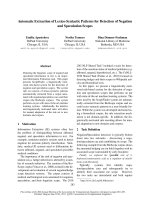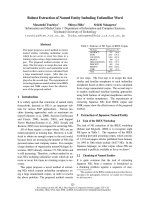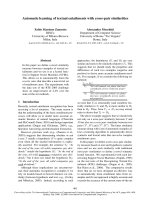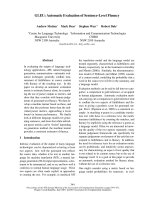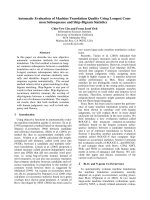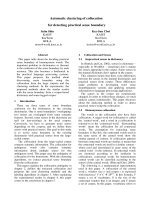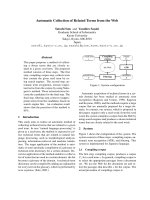Báo cáo khoa học: "Automatic Discovery of Named Entity Variants – Grammar-driven Approaches to Non-alphabetical Transliterations" pptx
Bạn đang xem bản rút gọn của tài liệu. Xem và tải ngay bản đầy đủ của tài liệu tại đây (240.11 KB, 4 trang )
Proceedings of the ACL 2007 Demo and Poster Sessions, pages 153–156,
Prague, June 2007.
c
2007 Association for Computational Linguistics
Automatic Discovery of Named Entity Variants
– Grammar-driven Approaches to Non-alphabetical Transliterations
Chu-Ren Huang
Institute of Linguistics
Academia Sinica, Taiwan
Petr
ˇ
Simon
Institute of Linguistics
Academia Sinica, Taiwan
Shu-Kai Hsieh
DoFLAL
NIU, Taiwan
Abstract
Identification of transliterated names is a
particularly difficult task of Named Entity
Recognition (NER), especially in the Chi-
nese context. Of all possible variations of
transliterated named entities, the difference
between PRC and Taiwan is the most preva-
lent and most challenging. In this paper, we
introduce a novel approach to the automatic
extraction of diverging transliterations of
foreign named entities by bootstrapping co-
occurrence statistics from tagged and seg-
mented Chinese corpus. Preliminary experi-
ment yields promising results and shows its
potential in NLP applications.
1 Introduction
Named Entity Recognition (NER) is one of the most
difficult problems in NLP and Document Under-
standing. In the field of Chinese NER, several
approaches have been proposed to recognize per-
sonal names, date/time expressions, monetary and
percentage expressions. However, the discovery of
transliteration variations has not been well-studied
in Chinese NER. This is perhaps due to the fact
that the transliteration forms in a non-alphabetic lan-
guage such as Chinese are opaque and not easy to
compare. On the hand, there is often more than
one way to transliterate a foreign name. On the
other hand, dialectal difference as well as differ-
ent transliteration strategies often lead to the same
named entity to be transliterated differently in dif-
ferent Chinese speaking communities.
Corpus Example (Clinton) Frequency
XIN 克林頓 24382
CNA 克林頓 150
XIN 柯林頓 0
CNA 柯林頓 120842
Table 1: Distribution of two transliteration variants
for ”Clinton” in two sub-corpora
Of all possible variations, the cross-strait differ-
ence between PRC and Taiwan is the most prevalent
and most challenging.
1
The main reason may lie in
the lack of suitable corpus.
Even given some subcorpora of PRC and Taiwan
variants of Chinese, a simple contrastive approach is
still not possible. It is because: (1) some variants
might overlap and (2) there are more variants used
in each corpus due to citations or borrowing cross-
strait. Table 1 illustrates this phenomenon, where
CNA stands for Central News Agency in Taiwan,
XIN stands for Xinhua News Agency in PRC, re-
spectively.
With the availability of Chinese Gigaword Cor-
pus (CGC) and Word Sketch Engine (WSE) Tools
(Kilgarriff, 2004). We propose a novel approach
towards discovery of transliteration variants by uti-
lizing a full range of grammatical information aug-
mented with phonological analysis.
Existing literatures on processing of translitera-
tion concentrate on the identification of either the
transliterated term or the original term, given knowl-
edge of the other (e.g. (Virga and Khudanpur,
1
For instance, we found at least 14 transliteration variants
for Lewinsky,such as 呂茵斯基, 呂文絲基,呂茵斯,陸文斯基,陸茵斯 基,
柳思基,陸雯絲姬, 陸文斯基,呂茵斯基,露文斯基, 李文斯基,露溫 斯基, 蘿恩斯
基,李雯斯基 and so on.
153
2003)). These studies are typically either rule-based
or statistics-based, and specific to a language pair
with a fixed direction (e.g. (Wan and Verspoor,
1998; Jiang et al., 2007)). To the best of our knowl-
edge, ours is the first attempt to discover transliter-
ated NE’s without assuming prior knowledge of the
entities. In particular, we propose that transliteration
variants can be discovered by extracting and com-
paring terms from similar linguistic context based
on CGC and WSE tools. This proposal has great po-
tential of increasing robustness of future NER work
by enabling discovery of new and unknown translit-
erated NE’s.
Our study shows that resolution of transliterated
NE variations can be fully automated. This will have
strong and positive implications for cross-lingual
and multi-lingual informational retrieval.
2 Bootstrapping transliteration pairs
The current study is based on Chinese Gigaword
Corpus (CGC) (Graff el al., 2005), a large corpus
contains with 1.1 billion Chinese characters contain-
ing data from Central News Agency of Taiwan (ca.
700 million characters), Xinhua News Agency of
PRC (ca. 400 million characters). These two sub-
corpora represent news dispatches from roughly the
same period of time, i.e. 1990-2002. Hence the two
sub-corpora can be expected to have reasonably par-
allel contents for comparative studies.
2
The premises of our proposal are that transliter-
ated NE’s are likely to collocate with other translit-
erated NE’s, and that collocates of a pair of translit-
eration variants may form contrasting pairs and are
potential variants. In particular, since the transliter-
ation variations that we are interested in are those
between PRC and Taiwan Mandarin, we will start
with known contrasting pairs of these two language
variants and mine potential variant pairs from their
collocates. These potential variant pairs are then
checked for their phonological similarity to deter-
mine whether they are true variants or not. In order
to effectively select collocates from specific gram-
matical constructions, the Chinese Word Sketch
3
is
adopted. In particular, we use the Word Sketch dif-
2
To facilitate processing, the complete CGC was segmented
and POS tagged using the Academia Sinica segmentation and
tagging system (Ma and Huang, 2006).
3
ference (WSDiff) function to pick the grammatical
contexts as well as contrasting pairs. It is important
to bear in mind that Chinese texts are composed of
Chinese characters, hence it is impossible to com-
pare a transliterated NE with the alphabetical form
in its original language. The following characteris-
tics of a transliterated NE’s in CGC are exploited to
allow discovery of transliteration variations without
referring to original NE.
• frequent co-occurrence of named entities
within certain syntagmatic relations – named
entities frequently co-occur in relations such as
AND or OR and this fact can be used to collect
and score mutual predictability.
• foreign named entities are typically transliter-
ated phonetically – transliterations of the same
name entity using different characters can be
matched by using simple heuristics to map their
phonological value.
• presence and co-occurrence of named entities
in a text is dependent on a text type – journalis-
tic style cumulates many foreign named entities
in close relations.
• many entities will occur in different domains
– famous person can be mentioned together
with someone from politician, musician, artist
or athlete. Thus allows us to make leaps from
one domain to another.
There are, however, several problems with the
phonological representation of foreign named enti-
ties in Chinese. Due to the nature of Chinese script,
NE transliterations can be realized very differently.
The following is a summary of several problems that
have to be taken into account:
• word ending: 阿拉法 vs.阿拉法特 ”Arafat” or 穆
巴拉 vs.穆巴拉克 ”Mubarak”. The final conso-
nant is not always transliterated. XIN translit-
erations tend to try to represent all phonemes
and often add vowels to a final consonant to
form a new syllable, whereas CNA transliter-
ation tends to be shorter and may simply leave
out a final consonant.
• gender dependent choice of characters: 萊絲 莉
”Leslie” vs.萊斯利 ”Chris” or 克莉絲特 vs. 克莉斯
154
特. Some occidental names are gender neutral.
However, the choice of characters in a personal
name in Chinese is often gender sensitive. So
these names are likely to be transliterated dif-
ferently depending on the gender of its referent.
• divergent representations caused by scope of
transliteration, e.g. both given and surname
vs. only surname: 大威廉絲 / 維‧威 廉絲 ”Venus
Williams”.
• difference in phonological interpretation: 賴夫
特 vs. 拉夫特 ”Rafter” or 康諾斯 vs. 康那斯 ”Connors”.
• native vs. non-native pronunciation: 艾斯庫 德
vs. 伊斯庫德 ”Escudero” or 費德洛 vs. 費德勒
”Federer”.
2.1 Data collection
All data were collected from Chinese Gigaword Cor-
pus using Chinese Sketch Engine with WSDiff
function, which provides side-by-side syntagmatic
comparison of Word Sketches for two different
words. WSDiff query for w
i
and w
j
returns pat-
terns that are common for both words and also pat-
terns that are particular for each of them. Three data
sets are thus provided. We neglect the common pat-
terns set and concentrate only on the wordlists spe-
cific for each word.
2.2 Pairs extraction
Transliteration pairs are extracted from the two sets,
A and B, collected with WSDiff using default set
of seed pairs :
- for each seed pair in seeds retrieve WSDiff for
and/or relation, thus have pairs of word lists,
< A
i
, B
i
>
- for each word w
ii
∈ A
i
find best matching
counterpart(s) w
ij
∈ B
i
. Comparison is done
using simple phonological rules, viz. 2.3
- use newly extracted pairs as new seeds (original
seeds are stored as good pairs and not queried
any more)
- loop until there are no new pairs
Notice that even though substantial proportion of
borrowing among different communities, there is no
mixing in the local context of collocation, which
means, local collocation could be the most reliable
way to detect language variants with known variants.
2.3 Phonological comparison
All word forms are converted from Chinese script
into a phonological representation
4
during the pairs
extraction phase and then these representations are
compared and similarity scores are given to all pair
candidates.
A lot of Chinese characters have multiple pro-
nunciations and thus multiple representations are de-
rived. In case of multiple pronunciations for certain
syllable, this syllable is commpared to its counter-
part from the other set. E.g. (葉 has three pronunci-
ations: y
`
e, xi
´
e, sh
`
e. When comparing syllables such
as 裴[pei,fei] and 斐[fei], 裴 will be represented as
[fei]. In case of pairs such as 葉爾欽 [ye er qin] and
葉爾侵 [ye er qin], which have syllables with multi-
ple pronunciations and this multiple representations.
However, since these two potential variants share
the first two characters (out of three), they are con-
sidered as variants without superfluous phonological
checking.
Phonological representations of whole words are
then compared by Levenstein algorithm, which is
widely used to measure the similarity between two
strings. First, each syllable is split into initial and
final components: gao:g+ao. In case of syllables
without initials like er, an ’ is inserted before the
syllable, thus er:’+er.
Before we ran the Levenstein measure, we also
apply phonological corrections on each pair of can-
didate representations. Rules used for these cor-
rections are derived from phonological features of
Mandarin Chinese and extended with few rules
from observation of the data: (1) For Initials, (a):
voiced/voiceless stop contrasts are considered as
similar for initials: g:k, e.g. 高 [gao] (高爾) vs. 科
[ke] (科爾),d:t, b:p, (b): r:l 瑞 [rui] (柯吉瑞夫) 列 [lie]
(科濟列夫) is added to distinctive feature set based on
observation. (2). For Finals, (a): pair ei:ui is eval-
uated as equivalent.
5
(b): oppositions of nasalised
final is evaluated as dissimilar.
4
/>5
Pinyin representation of phonology of Mandarin Chinese
does not follow the phonological reality exactly: [ui] = [uei]
etc.
155
2.4 Extraction algorithm
Our algorithm will potentially exhaust the whole
corpus, i.e. find most of the named entities that oc-
cur with at least few other names entities, but only
if seeds are chosen wisely and cover different do-
mains
6
. However, some domains might not over-
lap at all, that is, members of those domains never
appear in the corpus in relation and/or. And con-
currence of members within some domains might be
sparser than in other, e.g. politicians tend to be men-
tioned together more often than novelists. Nature of
the corpus also plays important role. It is likely to
retrieve more and/or related names from journal-
istic style. This is one of the reasons why we chose
Chinese Gigaword Corpus for this task.
3 Experiment and evaluation
We have tested our method on the Chinese Giga-
word Second Edition corpus with 11 manually se-
lected seeds Apart from the selection of the starter
seeds, the whole process is fully automatic. For this
task we have collected data from syntagmatic rela-
tion and/or, which contains words co-occurring
frequently with our seed words. When we make a
query for peoples names, it is expected that most of
the retrieved items will also be names, perhaps also
names of locations, organizations etc.
The whole experiment took 505 iterations in
which 494 pairs were extracted.
Our complete experiment with 11 pre-selected
transliteration pairs as seed took 505 iterations to
end. The iterations identified 494 effective transliter-
ation variant pairs (i.e. those which were not among
the seeds or pairs identified by earlier iteration.) All
the 494 candidate pairs were manually evaluated 445
of them are found to be actual contrast pairs, a pre-
cision of 90.01%. In addition, the number of new
transliteration pairs yielded is 4,045%, a very pro-
ductive yield for NE discovery.
Preliminary results show that this approach is
competitive against other approaches reported in
previous studies. Performances of our algorithms is
calculated in terms of precision rate with 90.01%.
6
The term domain refers to politics,music,sport, film etc.
4 Conclusion and Future work
In this paper, we have shown that it is possible to
identify NE’s without having prior knowledge of
them. We also showed that, applying WSE to re-
strict grammatical context and saliency of colloca-
tion, we are able to effectively extract transliteration
variants in a language where transliteration is not
explicitly represented. We also show that a small
set of seeds is all it needs for the proposed method
to identify hundreds of transliteration variants. This
proposed method has important applications in in-
formation retrieval and data mining in Chinese data.
In the future, we will be experimenting with a dif-
ferent set of seeds in a different domain to test the
robustness of this approach, as well as to discover
transliteration variants in our fields. We will also be
focusing on more refined phonological analysis. In
addition, we would like to explore the possibility of
extending this proposal to other language pairs.
References
Jiang, L. and M.Zhou and L.f. Chien. 2007. Named En-
tity Discovery based on Transliteration and WWW [In
Chinese]. Journal of the Chinese Information Process-
ing Society. 2007 no.1. pp.23-29.
Graff, David et al. 2005. Chinese Gigaword Second Edi-
tion. Linguistic Data Consortium, Philadelphia.
Ma, Wei-Yun and Huang, Chu-Ren. 2006. Uniform and
Effective Tagging of a Heterogeneous Giga-word Cor-
pus. Presented at the 5th International Conference on
Language Resources and Evaluation (LREC2006), 24-
28 May. Genoa, Italy.
Kilgarriff, Adam et al. 2004. The Sketch Engine. Pro-
ceedings of EURALEX 2004. Lorient, France.
Paola Virga and Sanjeev Khudanpur. 2003. Translit-
eration of proper names in cross-lingual information
retrieval. In Proc. of the ACL Workshop on Multi-
lingual Named Entity Recognition, pp.57-64.
Wan, Stephen and Cornelia Verspoor. 1998. Auto-
matic English-Chinese Name Transliteration for De-
velopment of Multiple Resources. In Proc. of COL-
ING/ACL, pp.1352-1356.
156
